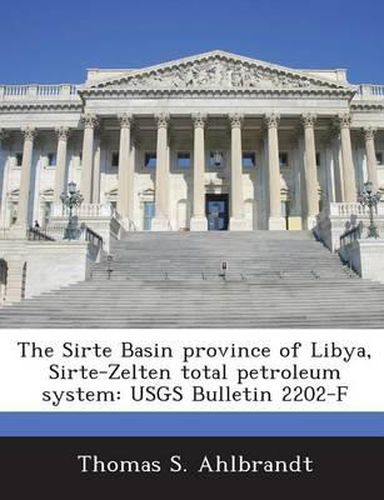Readings Newsletter
Become a Readings Member to make your shopping experience even easier.
Sign in or sign up for free!
You’re not far away from qualifying for FREE standard shipping within Australia
You’ve qualified for FREE standard shipping within Australia
The cart is loading…






The Sirte (Sirt) Basin province ranks 13th among the world’s petroleum provinces, having known reserves of 43.1 bil-lion barrels of oil equivalent (36.7 billion barrels of oil, 37.7 tril-lion cubic feet of gas, 0.1 billion barrels of natural gas liquids). It includes an area about the size of the Williston Basin of the north-ern United States and southern Canada (?490,000 square kilome-ters). The province contains one dominant total petroleum system, the Sirte-Zelten, based on geochemical data. The Upper Cretaceous Sirte Shale is the primary hydrocarbon source bed. Reservoirs range in rock type and age from fractured Precam-brian basement, clastic reservoirs in the Cambrian-Ordovician Gargaf sandstones, and Lower Cretaceous Nubian (Sarir) Sand-stone to Paleocene Zelten Formation and Eocene carbonates commonly in the form of bioherms. More than 23 large oil fields (>100 million barrels of oil equivalent) and 16 giant oil fields (>500 million barrels of oil equivalent) occur in the province. Abstract 1 Production from both clastic and carbonate onshore reservoirs is associated with well-defined horst blocks related to a triple junc-tion with three arms?an eastern Sarir arm, a northern Sirte arm, and a southwestern Tibesti arm. Stratigraphic traps in combina-tion with these horsts in the Sarir arm are shown as giant fields (for example, Messla and Sarir fields in the southeastern portion of the province). Significant potential is identified in areas marginal to the horsts, in the deeper grabens and in the offshore area. Four assessment units are defined in the Sirte Basin prov-ince, two reflecting established clastic and carbonate reservoir areas and two defined as hypothetical units. Of the latter, one is offshore in water depths greater than 200 meters, and the other is onshore where clastic units, mainly of Mesozoic age, may be res-ervoirs for laterally migrating hydrocarbons that were generated in the deep-graben areas. The Sirte Basin reflects significant rifting in the Early Cre-taceous and syn-rift sedimentary filling during Cretaceous through Eocene time, and post-rift deposition in the Oligocene and Miocene. Multiple reservoirs are charged largely by verti-cally migrating hydrocarbons along horst block faults from Upper Cretaceous source rocks that occupy structurally low posi-tions in the grabens. Evaporites in the middle Eocene, mostly post-rift, provide an excellent seal for the Sirte-Zelten hydrocarbon system. The offshore part of the Sirte Basin is complex, with subduction occurring to the northeast of the province boundary, which is drawn at the 2,000-meter isobath. Possible petroleum systems may be present in the deep offshore grabens on the Sirte Rise such as those involving Silurian and Eocene rocks; however, potential of these systems remains speculative and was not assessed.
$9.00 standard shipping within Australia
FREE standard shipping within Australia for orders over $100.00
Express & International shipping calculated at checkout
The Sirte (Sirt) Basin province ranks 13th among the world’s petroleum provinces, having known reserves of 43.1 bil-lion barrels of oil equivalent (36.7 billion barrels of oil, 37.7 tril-lion cubic feet of gas, 0.1 billion barrels of natural gas liquids). It includes an area about the size of the Williston Basin of the north-ern United States and southern Canada (?490,000 square kilome-ters). The province contains one dominant total petroleum system, the Sirte-Zelten, based on geochemical data. The Upper Cretaceous Sirte Shale is the primary hydrocarbon source bed. Reservoirs range in rock type and age from fractured Precam-brian basement, clastic reservoirs in the Cambrian-Ordovician Gargaf sandstones, and Lower Cretaceous Nubian (Sarir) Sand-stone to Paleocene Zelten Formation and Eocene carbonates commonly in the form of bioherms. More than 23 large oil fields (>100 million barrels of oil equivalent) and 16 giant oil fields (>500 million barrels of oil equivalent) occur in the province. Abstract 1 Production from both clastic and carbonate onshore reservoirs is associated with well-defined horst blocks related to a triple junc-tion with three arms?an eastern Sarir arm, a northern Sirte arm, and a southwestern Tibesti arm. Stratigraphic traps in combina-tion with these horsts in the Sarir arm are shown as giant fields (for example, Messla and Sarir fields in the southeastern portion of the province). Significant potential is identified in areas marginal to the horsts, in the deeper grabens and in the offshore area. Four assessment units are defined in the Sirte Basin prov-ince, two reflecting established clastic and carbonate reservoir areas and two defined as hypothetical units. Of the latter, one is offshore in water depths greater than 200 meters, and the other is onshore where clastic units, mainly of Mesozoic age, may be res-ervoirs for laterally migrating hydrocarbons that were generated in the deep-graben areas. The Sirte Basin reflects significant rifting in the Early Cre-taceous and syn-rift sedimentary filling during Cretaceous through Eocene time, and post-rift deposition in the Oligocene and Miocene. Multiple reservoirs are charged largely by verti-cally migrating hydrocarbons along horst block faults from Upper Cretaceous source rocks that occupy structurally low posi-tions in the grabens. Evaporites in the middle Eocene, mostly post-rift, provide an excellent seal for the Sirte-Zelten hydrocarbon system. The offshore part of the Sirte Basin is complex, with subduction occurring to the northeast of the province boundary, which is drawn at the 2,000-meter isobath. Possible petroleum systems may be present in the deep offshore grabens on the Sirte Rise such as those involving Silurian and Eocene rocks; however, potential of these systems remains speculative and was not assessed.